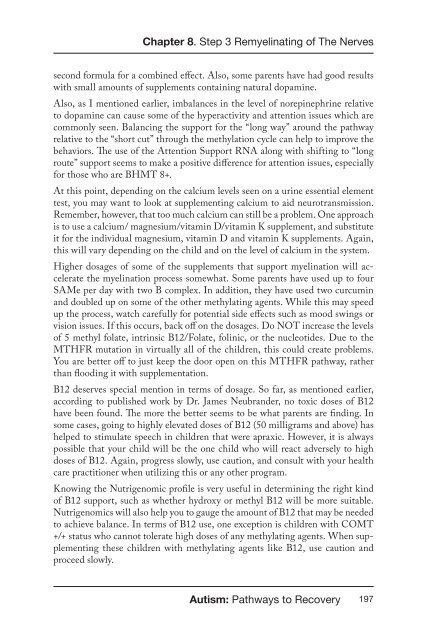3dT4E4Rnm
3dT4E4Rnm
3dT4E4Rnm
Create successful ePaper yourself
Turn your PDF publications into a flip-book with our unique Google optimized e-Paper software.
Chapter 8. Step 3 Remyelinating of The Nerves<br />
second formula for a combined effect. Also, some parents have had good results<br />
with small amounts of supplements containing natural dopamine.<br />
Also, as I mentioned earlier, imbalances in the level of norepinephrine relative<br />
to dopamine can cause some of the hyperactivity and attention issues which are<br />
commonly seen. Balancing the support for the “long way” around the pathway<br />
relative to the “short cut” through the methylation cycle can help to improve the<br />
behaviors. The use of the Attention Support RNA along with shifting to “long<br />
route” support seems to make a positive difference for attention issues, especially<br />
for those who are BHMT 8+.<br />
At this point, depending on the calcium levels seen on a urine essential element<br />
test, you may want to look at supplementing calcium to aid neurotransmission.<br />
Remember, however, that too much calcium can still be a problem. One approach<br />
is to use a calcium/ magnesium/vitamin D/vitamin K supplement, and substitute<br />
it for the individual magnesium, vitamin D and vitamin K supplements. Again,<br />
this will vary depending on the child and on the level of calcium in the system.<br />
Higher dosages of some of the supplements that support myelination will accelerate<br />
the myelination process somewhat. Some parents have used up to four<br />
SAMe per day with two B complex. In addition, they have used two curcumin<br />
and doubled up on some of the other methylating agents. While this may speed<br />
up the process, watch carefully for potential side effects such as mood swings or<br />
vision issues. If this occurs, back off on the dosages. Do NOT increase the levels<br />
of 5 methyl folate, intrinsic B12/Folate, folinic, or the nucleotides. Due to the<br />
MTHFR mutation in virtually all of the children, this could create problems.<br />
You are better off to just keep the door open on this MTHFR pathway, rather<br />
than flooding it with supplementation.<br />
B12 deserves special mention in terms of dosage. So far, as mentioned earlier,<br />
according to published work by Dr. James Neubrander, no toxic doses of B12<br />
have been found. The more the better seems to be what parents are finding. In<br />
some cases, going to highly elevated doses of B12 (50 milligrams and above) has<br />
helped to stimulate speech in children that were apraxic. However, it is always<br />
possible that your child will be the one child who will react adversely to high<br />
doses of B12. Again, progress slowly, use caution, and consult with your health<br />
care practitioner when utilizing this or any other program.<br />
Knowing the Nutrigenomic profile is very useful in determining the right kind<br />
of B12 support, such as whether hydroxy or methyl B12 will be more suitable.<br />
Nutrigenomics will also help you to gauge the amount of B12 that may be needed<br />
to achieve balance. In terms of B12 use, one exception is children with COMT<br />
+/+ status who cannot tolerate high doses of any methylating agents. When supplementing<br />
these children with methylating agents like B12, use caution and<br />
proceed slowly.<br />
Autism: Pathways to Recovery<br />
197


